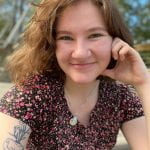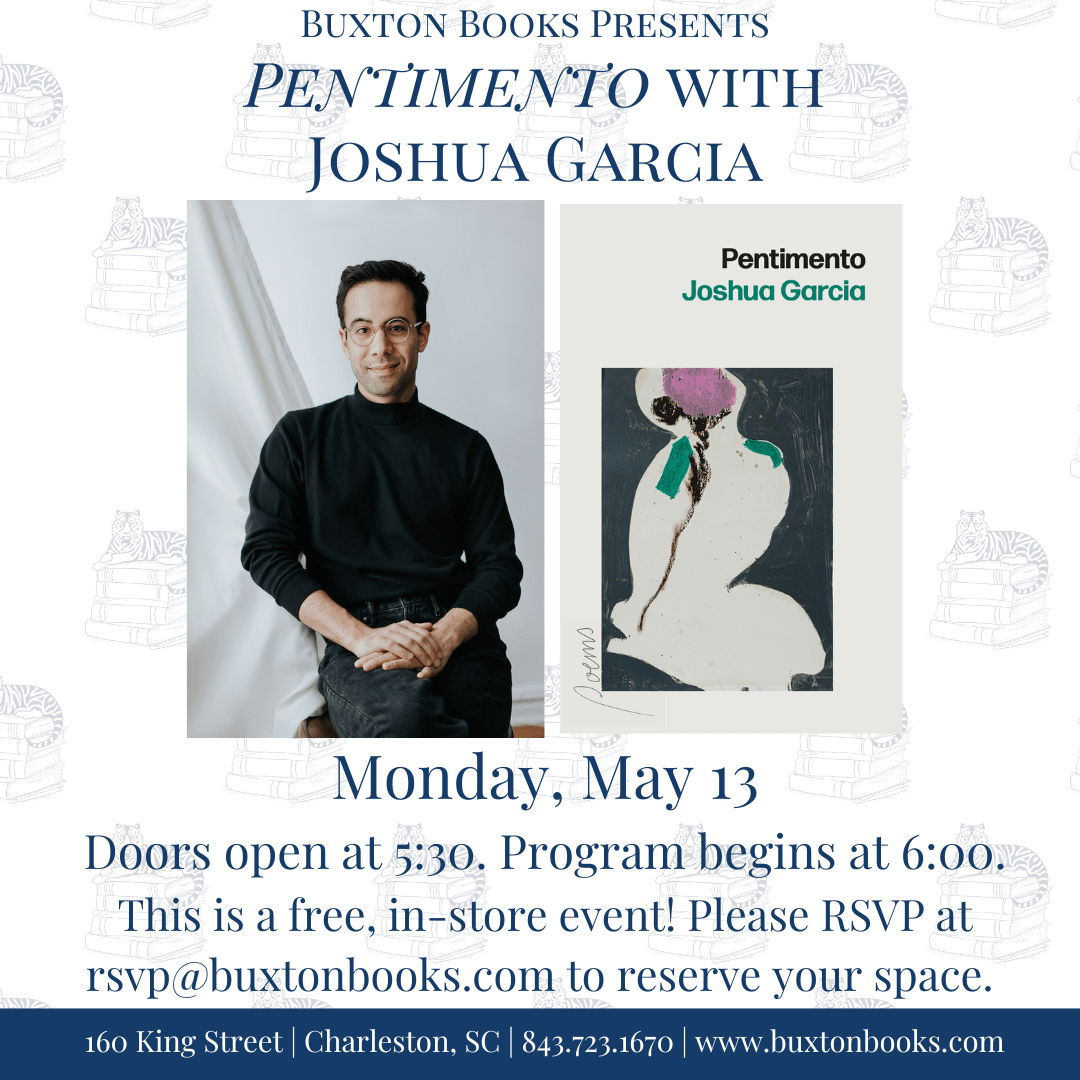Author Archives: Anthony Varallo
MFA Alum Joshua Garcia reading at Buxton Books, May 13, 6pm
Meet Peyton Niemeyer, Woodfin Fellow in Fiction
Suz Guthmann interviewed Peyton Niemeyer, our new Woodfin Fellow in Fiction.
What draws you to short story (or fiction) as your form?
I love writing stories in shorter form because I love the simplicity of it. I’m ways it’s almost like the bedtime stories we are read as kids. It can be read in one sitting and you can have a whole experience in such a short time. Novels I love because you begin to bong more with the characters and you watch them change and grow. And writing in that form is so nice because you learn a bit about yourself through creating people that don’t really exist outside of yourself.
How have you found your writing is affected by moving away from home?
My environment has a large impact on what I write. When I was living up North, my writing was colder and on a certain level almost bleak. But now that I’m living in a warmer and more tropical climate, I noticed my stories started to feel more warm and more optimistic. I use warmer colors and warmer themes.
Who influences your writing?
I have a lot of influences, but my literary influences would be Hemingway, Kafka, and more recently Claire Keegan. I love Hemingway’s ability to say a lot with so little and I love Kafka’s magical realism elements in many of his short stories. And Claire Keegan has a way of creating settings that I like to rest in. She also says a lot with very little.
What writer makes you feel at home?
As I previously stated, I love Keegan’s settings and how you feel comfortable in them. Comfortable doesn’t necessarily mean happy or pleasant. But her descriptions are so vivid that my brain knows exactly what to paint in my mind’s eye.
How do you write? Set the scene for us.
When I write, I like to hand write the plot out in my notebook and then when I begin writing that actual story I mostly handwrite because it keeps my scattered brain focused. But even then, I often times bounce between writing in my notebook, to writing on my computer, to even writing in my notes app on my phone. Then when I am done, I put it all together on one document. I enjoy handwriting a lot of my stuff because it keeps me from wanting to revise as I’m working on the first draft. I can just underline something or cross it out or even just jot down a note to change something and I keep going.
When did you know you were a writer?
I wrote my first poem when I was seven, and I never really stopped. Reading was not something I really appreciated until I was a little older though. And I fell in love with it. The idea of creating something like that was fascinating to me and I got the chance to do that when I was a little older. I didn’t think I was going to turn it into a career until I was about ready to graduate high school and go into a major I knew I wouldn’t like. I was going to go into an OTS program after getting a bachelor’s in mechanical engineering. But before I even moved out, I changed my major to writing because I realized I wouldn’t be happy doing anything else. I love it.
What book do you wish you had written?
I am crazy about Tracks by Louise Erdrich. Her style forces you to slow down and take in everything she is trying to say. In that sense her work is almost like poetry because she makes you stop and really sit with every sentence, but not in a way that’s disruptive to the narrative. And magical realism is one of my favorite styles.
Meet Suz Guthmann, Woodfin Fellow in Poetry
Peyton Niemeyer interviewed Suz Guthmann, our new Woodfin Fellow in Poetry.
What draws you to poetry as your creative work?
To me, poetry is so universal – everyone can and should write down how they process the world around them. I love that in the intensely vulnerable, poetry is a beautiful way of helping the writer explain themselves and the world around them. For me, poetry is what I need to be able to process my experiences and emotions. On a lighter note, it is so fun! Poetry takes so many forms and can evolve in so many ways, it is always an adventure when I start writing!
What poets (or artists of any other form) have been your influences?
I am always so nervous answering this question, I think it would be easier to ask who my artistic heroes are! First, I have “Phenomenal Woman,” by Maya Angelou tattooed on my ribs. I try to live by her quote which says, “Do the best you can until you know better. Then when you know better, do that.” There is just so much grace in her words. I recently read Fatimah Asghar’s collection of poems, If They Come For Us. I love how playful her form is (Crosswords! Bingo sheets! Word searches!) and how she marries it with her tough subjects. I am a major fan of memoirs with a lot of my own work being semi-autobiographical, I so enjoyed reading Loose of Earth by Kathleen Dorothy Blackburn. Music wise, I rage out with Delilah Bon, especially to her song, “Clowns,” and love Rhiannon Giddens’ album, Freedom Highway.
When did you know that you were a writer?
I was trying to write before I could even read. My sweet cousin Elijah was my toddler pen pal, and we would send each other little drawings back and forth over snail mail. I would dictate stories to my mom for her to type, usually about bunnies and fairies! I bent towards journalism in college, serving as the Editor-in-Chief of our newspaper, The Bagpipe. I had written little poems all my life, but realized I was a poet much later when I began writing again after surviving sexual assault. Writing my story and understanding of events brought me to a place where I was able to ask for help, which really saved my life. I hope to help others find the courage to share their stories and destigmatize the subject of surviving sexual assault.
What is your go to form in your poetry?
Ah, I don’t know! I think I would be considered experimental. I don’t like to stick to one form but switch it up quite a bit. Recently, I’ve been taking portions of the DBT Skills Training Handouts and Worksheets, Second Edition by Marsha M. Line and constructing poems using its structure. DBT stands for dialectical behavior therapy used to teach mindfulness, interpersonal effectiveness, emotion regulation, and distress tolerance. It is especially useful for people who are dealing with post-traumatic stress disorder. Using the worksheets as a form of poetry really helps me contextualize each lesson and explain them to others.
What is your favorite picture book?
They All Saw a Cat by Brendan Wenzel, who won the Caldecott Honor in 2017. It’s a poem in its own way. “The cat walked through the world with its whiskers, ears, and paws,” past many other creatures, all who perceived the cat through their unique lens. The illustrations perfectly encapsulate these different lenses, like showing a single flea in a vast ocean of cat hair that takes up the entire page. Also, cats!
What is your writing process like?
Ooo boy, it is chaotic! I used to try to write a poem with a meaning in mind first and wow, was that unnatural. I have started paying more attention to those sudden flashes of imagery that I see around me, like a keg kicking at work and the spray of kombucha foam feeling like a drive by baptism. I find that I must scribble that image down before I lose it and then, maybe when my shift is done, I’ll come back to it and flesh it out. I think the oddest times I’ve found a poem would have to be in a hot tub, at a child’s birthday party, and in an Uber.
Congratulations to Michael Plunkett, MFA ’22, on selling his first novel!
Congratulations to the winners of the MFA Prizes in Poetry and Fiction!
We’re thrilled to announce the winners of this year’s MFA Prizes in Poetry and Fiction! Congratulations to all!
MFA Prizes in Poetry and Fiction
 Fiction: “I Struggle with the Idea of Permanence,” by Campbell Sullivan
Fiction: “I Struggle with the Idea of Permanence,” by Campbell Sullivan
 Poetry: “Sermon,” by Suz Guthmann
Poetry: “Sermon,” by Suz Guthmann
Special thanks to our fiction judge, Kim Magowan, and poetry judge, Ashley M. Jones!









